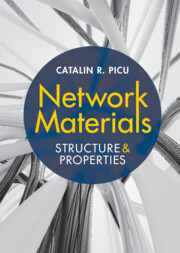Book contents
- Network Materials
- Network Materials
- Copyright page
- Contents
- Preface
- 1 Introduction
- 2 Fibers and Fiber Bundles
- 3 Fiber Interactions
- 4 Network Structure and Geometric Parameters
- 5 Affine Deformation
- 6 Mechanical Behavior and Relation to Structural Parameters
- 7 Constitutive Formulations for Network Materials
- 8 Strength and Toughness of Network Materials
- 9 Time Dependent Behavior
- 10 Networks with Fiber Surface Interactions
- 11 Composite Networks
- Index
- References
10 - Networks with Fiber Surface Interactions
Networks of Fiber Bundles
Published online by Cambridge University Press: 15 September 2022
- Network Materials
- Network Materials
- Copyright page
- Contents
- Preface
- 1 Introduction
- 2 Fibers and Fiber Bundles
- 3 Fiber Interactions
- 4 Network Structure and Geometric Parameters
- 5 Affine Deformation
- 6 Mechanical Behavior and Relation to Structural Parameters
- 7 Constitutive Formulations for Network Materials
- 8 Strength and Toughness of Network Materials
- 9 Time Dependent Behavior
- 10 Networks with Fiber Surface Interactions
- 11 Composite Networks
- Index
- References
Summary
In many networks, fibers interact though surface interactions such as cohesion and capillarity, which cause fiber bundling. In adequate conditions, the same process leads to the formation of percolated networks of fiber bundles. These have a specific structure and their mechanical properties are quite different from those of regular networks of fibers and molecular filaments. Separate sections are dedicated to crosslinked and non-crosslinked networks with surface interactions. Surface interactions perturb weakly the structure of crosslinked networks, but have a significant effect on their mechanics. If the network is not crosslinked, surface interactions reorganize the network and define the resulting structure. The properties of networks of fiber bundles embedded in solvents (colloidal suspensions) and in the dry state (buckypaper) are discussed in separate sections.
Keywords
- Type
- Chapter
- Information
- Network MaterialsStructure and Properties, pp. 370 - 392Publisher: Cambridge University PressPrint publication year: 2022



